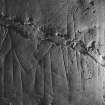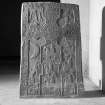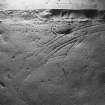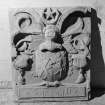Rossie Church
Burial Ground (Medieval), Church (Medieval), Mausoleum (19th Century) - (20th Century)
Site Name Rossie Church
Classification Burial Ground (Medieval), Church (Medieval), Mausoleum (19th Century) - (20th Century)
Alternative Name(s) Kinnaird Mausoleum; Old Kirk Of Rossie; Rossie Priory Policies
Canmore ID 30648
Site Number NO23SE 4
NGR NO 29161 30807
Datum OSGB36 - NGR
Permalink http://canmore.org.uk/site/30648
- Council Perth And Kinross
- Parish Inchture
- Former Region Tayside
- Former District Perth And Kinross
- Former County Perthshire
Rossie Priory, Old Kirk of Rossie, Perthshire, Pictish cross-slab
Measurements: H 1.68m, W 1.17m, D 0.30m
Stone type: sandstone
Place of discovery: NO 2915 3085
Present location: Kinnaird Mausoleum (Old Kirk of Rossie)
Evidence for discovery: recorded by Stuart in the old kirkyard in the mid nineteenth century.
Present condition: some wear and the left arm of the cross has been defaced.
Description
This very substantial slab is carved in both incision and low relief on both broad faces with a wealth of detail. There is a cross on both faces but whereas the background on face A is dominated by mythological animals, that on face C is dominated by secular themes. On face A the arms of the quadrilobate cross extend out to the edges of the slab, and the entire cross is outlined by a roll moulding, as is the circular disc at its centre. The cross is designed as an equal-armed cross with squared terminals on a short shaft, and the cross appears again in the voids of the interlace filling the central disc. The upper and lower arms are filled with interlace, while the one surviving side-arm is filled with square key pattern. There are also traces of key pattern on the arcs between the arms. The shaft contains looped interlace forming eight circular patterns. To the right of the upper arm is a ‘formidable man’ symbol wearing an animal mask and threatening with a large axe the bird in front of him, whose head is turned back to watch the axe. A beast’s head symbol is tucked in below the bird. On the left of the upper arm is a quadruped with bird’s feet and a human head. There are three cameo scenes one above the other on either side of the lower arm and shaft: to the right, a kneeling quadruped with head turned back to capture in its jaws the head of a serpent entwined through its body, above a horned and goggle-eyed beast and, at the bottom two entwined beasts. These last have human forelegs and human bearded heads on elongated necks. They face away from one another, as do their entwined serpent-headed tails. On the left, a long-necked beast walks left over a beast with ball and claw feet, also facing left, with its jaws clamped round the head of a human figure with arms and legs flailing. His right ankle is captured in the jaws of a serpent with a fishtail. Below again are two confronted beasts, each holding in its mouth the head of a long-necked bird, the body of which lies over the beast’s shoulder.
On face C there is a wide decorative border along the sides and the top, and the interlace filling the cross flows out of the top and side-arms into the border. The cross is again outlined by roll moulding, but here the moulding continues round the spaces around the cross. A central disc is defined by a roll moulding and filled with square key pattern. The lower arm of the cross contains a vignette of an aristocratic horseman riding to the left on a high-stepping horse, and there are two similar horsemen, bearded and apparently unarmed, in the shaft below. To the left of the upper arm is a striding man holding a large bird by the neck in each hand. These birds have been identified as cranes. To the right of the upper arm is a stylised angel. To the left of the lower arm and shaft are two Pictish symbols, crescent and V-rod and Pictish beast, above a kneeling beast with a second head at the end of its tail. To the right of the shaft are two horseriders, the lower of which appears to be a woman sitting side-saddle on a stationary horse, while the bearded rider above is on a galloping horse, with two hunting dogs above him.
Date: eighth or ninth century.
References: Stuart 1867, pl 98; ECMS pt 3, 306-8; RCAHMS 1994, 103; Fraser 2008, no 191.
Compiled by A Ritchie 2016
NO23SE 4.00 29161 30807
NO23SE 4.01 2915 3080 Pictish Cross-slab
(NO 2915 3080) Rossie Church (NR)
OS 6" map (1959)
The church is situated on a terrace overlooking the site of the old village of Rossie (NO23SE 5). A Pictish cross-slab found in the burial ground is now in the church.
(Undated) information in NMRS.
The old Kirk of Rossie probably occupies the site of an ancient monastic foundation as early records mention 'The Abbacy of Rossie'. Whether Culdee or Latin is not known but it was probably Culdee as it was gifted by David I (who suppressed the Culdees) to Matthew, Archdeacon of St Andrews, who in his turn conveyed the foundation and lands to the canons of St Andrews, a gift confirmed by Malcolm IV, a charter of whom refers to the village, church, and church-lands of 'Rossie-clerauch'.
In 1243 the church of Rossie was consecrated and dedicated to St Lawrence the Martyr and St Coman, Confessor. The old church was abandoned in 1670 when the parish was united with Inchture.
The building was restored as a memorial chapel in the 19th c.
An upright cross-slab, 5 1/2' high, bearing symbols, was found in the old burial ground (NO 291 307) and is now preserved in the church.
A H Millar 1890; D E Easson 1957; J Stuart 1867; J R Allen and J Anderson 1903
NO23SE 4.00 29161 30807
NMRS REFERENCE:
Architect: T. S. Robertson - rebuilding, c 1870.
Thomas Campbell recumbent marble of Victor Alexander Kinnaird, 1854.
William Brodie recumbent marble of Olivia Barbara Kinnaird, 1871. Also several other marbles, monuments and busts.
G. Webb Gilbert tablet and bust of Douglas Arthur Kinnaird, 1914.
Field Visit (4 February 1969)
About the end of the 19th c, Rossie Church was restored by a member of the Kinnaird family for use as an Anglican Chapel. It was never used as such, but was adapted as a mausoleum for the Kinnaird family (Mr Perkins, butler, Rossie Priory, Inchture).
The symbol stone is still in the church, while several 17th c gravestones can be seen in the graveyard which is still used occasionally.
Visited by OS (RD) 4 February 1969.
Field Visit (8 June 1976)
No change to previous field report.
Visited by OS (JM) 8 June 1976.
Field Visit (6 April 1989)
Rossie church comprises a nave and chancel, and measures 20.5m from W to E by 6.9m transversely over all. Its walls measure 0.85m in thickness and are of a random rubble build. Although almost entirely rebuilt about 1870 (T S Robertson, architect), apparently on an earlier plan but with the addition of a S porch, buttresses, bell-cote and gothic
detail, the medieval fabric of the N and E walls remains largely intact. There is a chamfered offset on the E gable at the height of the main wall-head and the N entrance (arch-pointed, of two orders) is probably original. Restored for use as a memorial chapel for the Kinnaird family, the interior contains a fine collection of 19th-century funerary sculpture, a Pictish cross-slab (found about 1890 within the burial-ground, NO23SE 4.02) and, in the floor of the chancel, an incised slab of Tournai marble; the latter depicts a framed knight and lady and may date from about 1260. To the S of the church, there are a number of 17th- and 18th-century gravestones. The abthain of Rossie is on record in 1153 x 1159 and, given the presence of the Pictish cross-slab, may indicate the site of a Celtic foundation. A church is on record by 1160 x 1162, and was consecrated and dedicated to St Leonard the Martyr and St Coman, Confessor in 1243. In 1670 the parish was united with that of Inchture and, by 1792, the church was ruinous.
Visited by RCAHMS (IMS) 6 April 1989.
F A Greenhill 1958.


































































































